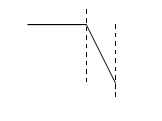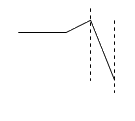



Pitch accent HL* is realized as a fall beginning at the onset of the accented vowel. It starts at high or mid pitch and falls to low at the end of the accented syllable. HL* does not necessarily end at the lowest pitch and a not-quite-low ending is in fact common. After the accented syllable, the pitch continues low or slowly falls further to the end of the utterance. In the pretonic syllable immediately before the accented syllable a small rise may occur, which makes the fall more salient ('raised peak'). In the examples, HL* occurs on words in a number of different positions of the utterance.
The main communicative function of this accent is completeness with emphasis. The raised peak in particular is associated with emphasis. Other functions are a wh-question with narrow focus, an imperative, addressing someone near you.
HL* examples 1-8 have been selected from spontaneous speech and express completeness with emphasis. Examples 9-15 have been selected from prepared speech and express other communicative functions that are indicated in the descriptions of these examples.
1. In this first example, pitch accent HL* expresses completeness with emphasis. It is preceded by two realizations of accent H*M.

2. This is another example of pitch accent HL* expressing completeness with emphasis. It is preceded by two realizations of pitch accent H*M.

3. In this example about the construction of a table, pitch accent ^HL*, preceded by pitch accent H*M, has a raised peak indicated with ^. It expresses completeness with emphasis.

4. Here is another example of pitch accent HL*, preceded by pitch accent H*M, now without a raised peak. Like the preceding examples it also expresses completeness with emphasis

5. In this example pitch accent HL* is preceded by two pitch accents H*M, and also expresses completeness with emphasis.

6. See 5.

7. See 1.

8. In this example pitch accent H*M is realized in the beginning of the utterance followed by a HL* realization at the end. This is a typical pitch pattern also known as a flat hat because of its form: a movement up in H*M followed by a slightly declining non-prominence lending pitch movement and ending with a movement down in HL*. The accent expresses completeness with emphasis.
Note that a flat hat can also be realized with a combination of H*H and HL* where the connecting non-prominence lending pitch movements are realized on the high level of high pitch target reached in H*H. The present example is more like a dented hat.

9. In the following utterance accent HL* realized in the words 'net' and 'popozzhe' expresses an emphatic answer to a question asked on the phone.


10. The next example is a question with accent HL* realized in the question word with narrow focus: it is clear that the television has been switched on, and the speaker asks about what specific channel was turned on. With accent HL* realized in the question word, the question sounds rather impolite and impatient to Russian ears.

11. In this example accent HL* also expresses a question with question word and narrow focus. The speaker knows that the book has been put somewhere, but where exactly? It sounds a bit impolite and impatient to Russian ears.

12. The following example is also a question with question word and narrow focus. But here the narrow focus is not expressed by accent HL* realized in the question word but in the word tebe 'to you'. The speaker knows that something has been said, but wonders who said it 'to you'.

13. In the next utterance accent HL* expresses a polite imperative to a person near the speaker. Note that if both first name and father's name are used, both names can be accented, but most commonly an accent is realized in the first name. Compare examples 13, 14 and 15.

14. In the next example the same imperative is used by another speaker addressing a person near her rather politely, but then the command sounds more impatient than in example 13. Accent HL* is preceded by a raised peak indicated with ^.

15. The following utterances present three more examples of a polite imperative addressed to someone near the speaker by realizing accent HL*.


